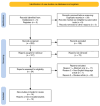Radiomic Features as Artificial Intelligence Prognostic Models in Glioblastoma: A Systematic Review and Meta-Analysis
- PMID: 39518322
- PMCID: PMC11545697
- DOI: 10.3390/diagnostics14212354
Radiomic Features as Artificial Intelligence Prognostic Models in Glioblastoma: A Systematic Review and Meta-Analysis
Abstract
Background: Glioblastoma, the predominant primary tumor among all central nervous systems, accounts for around 80% of cases. Prognosis in neuro-oncology involves assessing the disease's progression in different individuals, considering the time between the initial pathological diagnosis and the time until the disease worsens. A noninvasive therapeutic approach called radiomic features (RFs), which involves the application of artificial intelligence in MRI, has been developed to address this issue. This study aims to systematically gather evidence and evaluate the prognosis significance of radiomics in glioblastoma using RFs.
Methods: We conducted an extensive search across the PubMed, ScienceDirect, EMBASE, Web of Science, and Cochrane databases to identify relevant original studies examining the use of RFs to evaluate the prognosis of patients with glioblastoma. This thorough search was completed on 25 July 2024. Our search terms included glioblastoma, MRI, magnetic resonance imaging, radiomics, and survival or prognosis. We included only English-language studies involving human subjects, excluding case reports, case series, and review studies. The studies were classified into two quality categories: those rated 4-6 were considered moderate-, whereas those rated 7-9 were high-quality using the Newcastle-Ottawa Scale (NOS). Hazard ratios (HRs) and their 95% confidence intervals (CIs) for OS and PFS were combined using random effects models.
Results: In total, 253 studies were found in the initial search across the five databases. After screening the articles, 40 were excluded due to not meeting the eligibility criteria, and we included only 14 studies. All twelve OS and eight PFS trials were considered, involving 1.639 and 747 patients, respectively. The random effects model was used to calculate the pooled HRs for OS and PFS. The HR for OS was 3.59 (95% confidence interval [CI], 1.80-7.17), while the HR for PFS was 4.20 (95% CI, 1.02-17.32).
Conclusions: An RF-AI-based approach offers prognostic significance for OS and PFS in patients with glioblastoma.
Keywords: artificial intelligence; glioblastoma; overall survival; progression-free survival; radiomic features.
Conflict of interest statement
The authors declare no conflicts of interest.
Figures
Similar articles
-
Pretreatment MR-based radiomics in patients with glioblastoma: A systematic review and meta-analysis of prognostic endpoints.Eur J Radiol. 2023 Nov;168:111130. doi: 10.1016/j.ejrad.2023.111130. Epub 2023 Oct 5. Eur J Radiol. 2023. PMID: 37827087
-
Systematic review and epistemic meta-analysis to advance binomial AI-radiomics integration for predicting high-grade glioma progression and enhancing patient management.Sci Rep. 2025 May 8;15(1):16113. doi: 10.1038/s41598-025-98058-0. Sci Rep. 2025. PMID: 40341184 Free PMC article.
-
Change of Circulating and Tissue-Based miR-20a in Human Cancers and Associated Prognostic Implication: A Systematic Review and Meta-Analysis.Biomed Res Int. 2018 Nov 25;2018:6124927. doi: 10.1155/2018/6124927. eCollection 2018. Biomed Res Int. 2018. PMID: 30596096 Free PMC article.
-
Radiomics may increase the prognostic value for survival in glioblastoma patients when combined with conventional clinical and genetic prognostic models.Eur Radiol. 2021 Apr;31(4):2084-2093. doi: 10.1007/s00330-020-07335-1. Epub 2020 Oct 2. Eur Radiol. 2021. PMID: 33006658
-
Prediction of survival with multi-scale radiomic analysis in glioblastoma patients.Med Biol Eng Comput. 2018 Dec;56(12):2287-2300. doi: 10.1007/s11517-018-1858-4. Epub 2018 Jun 19. Med Biol Eng Comput. 2018. PMID: 29915951
Cited by
-
Artificial Intelligence in Glioblastoma-Transforming Diagnosis and Treatment.Chin Neurosurg J. 2025 Jun 2;11(1):10. doi: 10.1186/s41016-025-00399-2. Chin Neurosurg J. 2025. PMID: 40457483 Free PMC article. Review.
-
Late enhancement and wash-out maps for differentiation of glioblastoma and metastases.BMC Med Imaging. 2025 Aug 27;25(1):353. doi: 10.1186/s12880-025-01889-6. BMC Med Imaging. 2025. PMID: 40866807 Free PMC article.
References
Publication types
LinkOut - more resources
Full Text Sources




